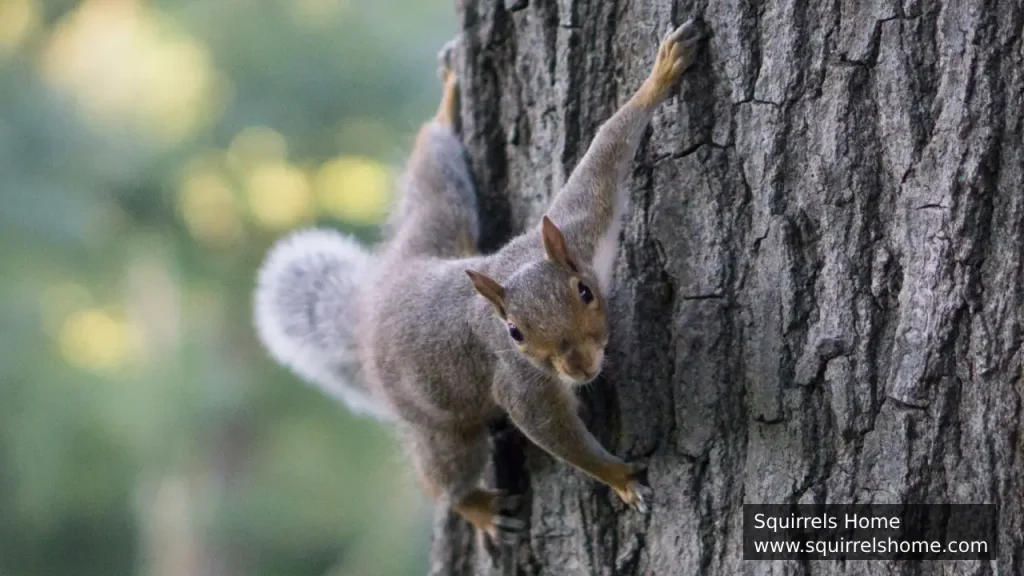Squirrels are fascinating creatures known for their agility and ability to move effortlessly among tree branches. But how do they keep their balance while leaping and climbing at such great heights? Let’s explore the simple methods squirrels use to stay steady as they move through trees.
Strong Tail for Balance
One of the most important tools squirrels have for maintaining balance is their tail. A squirrel’s tail acts like a counterweight. When they jump from branch to branch, their tail moves in the opposite direction of their body, helping them stay steady.
If a squirrel slips or loses balance, it uses its tail to adjust its position quickly. The tail’s constant movement helps keep the squirrel upright while it scurries along branches. Additionally, the tail serves as a parachute, slowing them down if they fall.
Sharp Claws for Gripping

Squirrels have sharp, curved claws that help them hold onto tree bark. These claws dig into the surface, giving them a firm grip even on thin branches. When climbing, the claws act like hooks, preventing them from slipping.
The claws are also very flexible, allowing squirrels to climb up and down with ease. They can grip tightly to rough or smooth surfaces, making trees their perfect playground.
Strong Muscles and Lightweight Body
A squirrel’s body is small and light, which helps them balance more easily on narrow branches. Their strong leg muscles let them jump long distances without losing control.
These muscles work with their lightweight frame to help them land safely. Squirrels can leap several times their body length and still stay balanced. Their agility is due to their powerful muscles and low body weight.
Amazing Coordination
Squirrels have great coordination. Their eyes, muscles, and brain work together perfectly to help them plan their movements. Before jumping, a squirrel looks carefully to choose the best branch to land on.
This planning helps them make precise movements. If something changes suddenly, such as a branch moving, they adjust their body mid-air to land safely. Their quick thinking and reflexes make them masters of tree travel.
Flexible Ankles for Climbing
Squirrels have unique ankle joints that can rotate almost completely around. This ability allows them to climb up and down trees headfirst. Most animals can’t do this because their ankles don’t bend that way.
When climbing down, their rotated ankles give them a strong grip on the tree bark. This makes them very efficient climbers, able to move in any direction without losing their balance.
Sensitive Whiskers and Feet
A squirrel’s whiskers and feet help them sense their surroundings. Whiskers can detect the width and texture of branches, letting squirrels know if a surface is safe.
Their feet are also very sensitive, allowing them to feel vibrations and movements in the tree. This helps them avoid weak or unsteady branches, keeping them safe and balanced as they move.
Practice and Instinct
Squirrels learn how to balance from a young age. Baby squirrels watch their parents and practice climbing until they get better. Over time, their movements become automatic.
Instinct also plays a big role. Squirrels are born with the ability to adjust their body to maintain balance. This natural skill helps them survive in their tree-filled habitats.
Using Their Tail for Communication
In addition to balance, a squirrel’s tail helps them communicate with other squirrels. The tail’s movements can warn others of danger or signal where food is located. These signals help squirrels coordinate with each other and avoid risky situations.
Conclusion
Squirrels have many features that help them stay balanced in trees. Their tail, claws, muscles, coordination, ankles, and sensory tools work together to keep them safe. They also rely on instinct and practice to become experts at moving through trees. These skills make squirrels some of the most agile animals in nature.
FAQs
1. Do squirrels ever fall from trees?
Yes, squirrels can fall, but they often use their tail to slow down and reduce the impact. Their lightweight body also helps them survive falls from great heights.
2. How far can squirrels jump between trees?
Squirrels can leap up to 10 feet or more. Their strong muscles and precise coordination allow them to make long jumps without losing balance.
3. Why don’t squirrels get tired while climbing?
Squirrels have strong muscles and efficient energy use. Their lightweight body also helps reduce strain, allowing them to climb for long periods.
4. Can squirrels climb smooth surfaces?
While squirrels prefer rough surfaces like tree bark, their sharp claws can grip some smooth materials. However, they’re less effective on very smooth surfaces.
5. Are squirrels good at balancing on wires?
Yes, squirrels can balance on wires due to their tail and sensitive feet. Their ability to adjust their body position helps them move safely on narrow surfaces like power lines.
